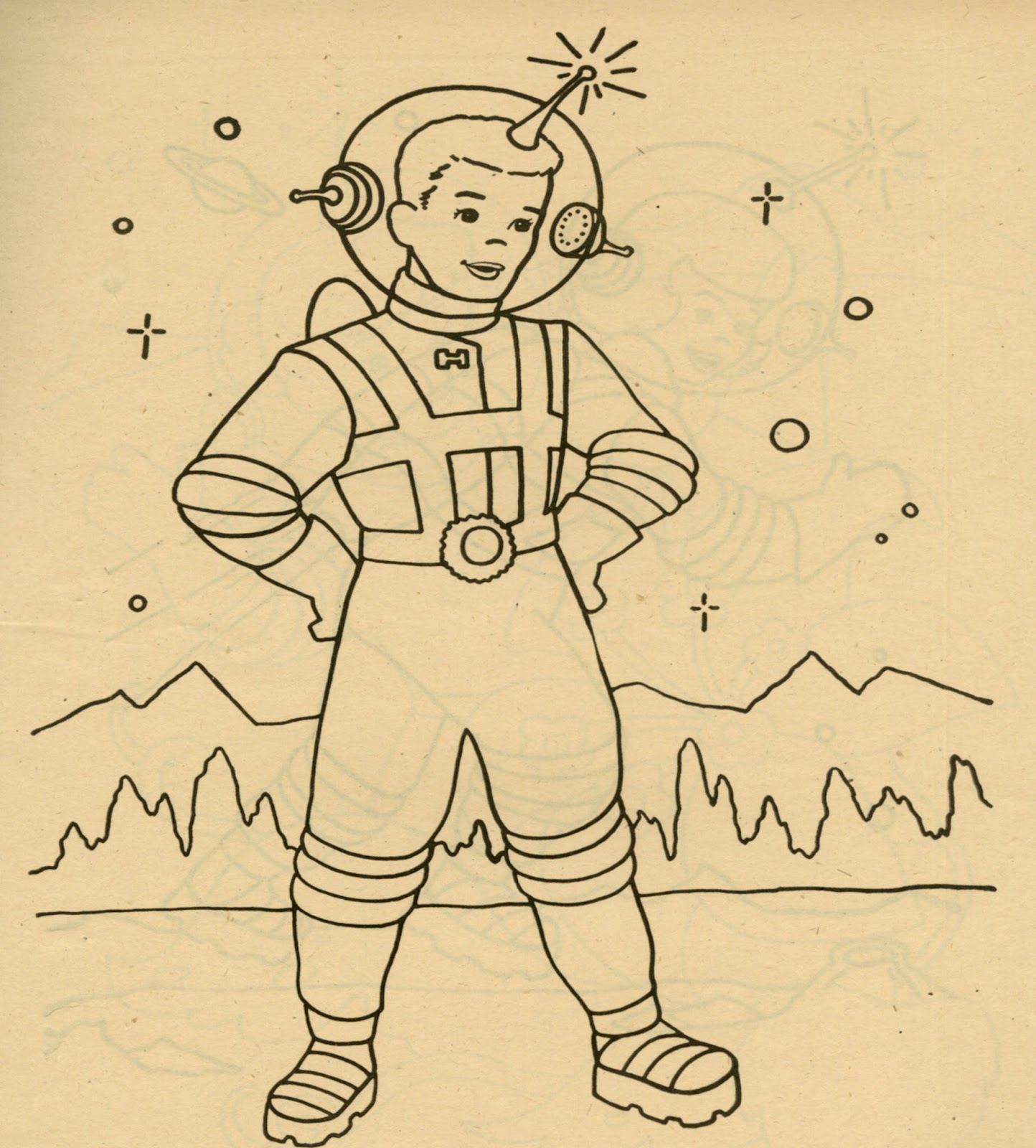Wednesday, April 30, 2014
Rags, Borya and the Rocket; a tale of home-less dogs and how they became famous (1964)
(English trans of Russian book: Tiapa, Borka i Paketa : povest o brodiachikh sobakakn, kotorye stali znamenitymi).
Baranova, M.P. and Veltistov, Y. Illustrated by Y. Migunov and K. Rotov. Rags, Borya and the Rocket; a tale of home-less dogs and how they became famous, 1964.
A story of the real "space dogs" of Russia mixed in with a fictional story of how a particular dog joined the space program. The illustrations are interesting.
There is also a rather satirical drawing near the end commenting on the coming space age.
Monday, April 21, 2014
TV Space Riders Coloring Book (1952)
Some cool old 50's images today. I notice how similar they seem to the Soviet ones of the same time period. Especially helicopters in space.
These are all rather traditional, drawing their spacesuits from the space television shows.
Both of these seem a little odd since I "read" the location as on the Moon (those jagged mountains). why did helicopters seem to "say" space age to artists who were trying to draw futuristic vistas?
This illustration is just wrong. Why do the children get (or need) space suits while the poor dog has to suck vacuum? There is also the small problem in how that ship behind them is going to take off. Maybe it was a one way trip.
And finally some cool spaceships/jets. I love like many of you all the different vehicles that people designed or just thought up when they were trying to show space flight.
A last note. Compare the cover of this coloring book to the boy and ship shown on this one:
http://dreamsofspace.blogspot.com/2012/03/zedo-into-space-1952.html
Maybe a little recycling went on at that company.
Wednesday, April 16, 2014
Spacecraft at Work (1965)
Spacecraft at work (1965) is kind of a random book. It has some interesting illustrations but it organized with subjects scattered randomly throughout the book. It might be one of those project created purely because "space sells" so they did not put a lot of effort into it.
Elting, Mary. Illustrated by Koering, Ursula. Spacecraft at Work. Irvington-on-Hudson, NY: Harvey House. (96 p.) 24 cm.
The illustrations are very beautiful and simple. The text and illustrations cover all aspects of space flight including space suits, Moon landings, recent space missions, and space stations. Also 1966 edition.
Monday, April 7, 2014
Adventure Stories for Boys and Girls (1966)
A bit of fun (and obscure) children's space fiction today from Adventure Stories for Boys and Girls (1966). As you can tell I like graphic design a great deal and this book is a charming fantasy about space flight. The chief graphically interesting story "Space Man Sam" is about a mouse that sneaks aboard the first space flight to Mars.
Adventure Stories for Boys and Girls. Illustrations by Vasco Americana. London: Rylee Ltd., 1966.(45 pp.)
I like see the various space books he is studying and his own scientific explorations. One of my viewers noted the title of the book is in Italian so probably this was a translation of an Italian children's book.
At this point he decides he must sneak aboard the space ship.
He reminds me of "Mighty Mouse" with his heroic pose here.
Mars seems a bit closer to earth (check the sky) than I thought but maybe Sam is distracted by the enthusiastic Martians who take him on a tour. I especially like this "flying sofa" as a way to see the sights.
Getting a copy of a recent Martian newspaper is the best way that Sam can bring back evidence of his trip to the earth scientists.
The book has one other space related story with less exciting illustrations:
Wednesday, April 2, 2014
Journey Into Tomorrow (1953)
Journey into Tomorrow seems to be about the glorious future awaiting Russian children and young adults. As always if someone wants to give me a better translation of the title I will change it. The best illustration in the book is really the cover.
And here is the title page for those who read Russian:
The book has a number of futuristic vehicles and concepts, devoting a chapter to each. These are similar to some of the other illustrations I have found from that time but they are still interesting.
The views of the future don't look that different from those design ideas found in Lang's 1927 film Metropolis. The urban crowding is a little less dense but the helicopter seems much the same.
There is the same "tank" I have seen in other books, very handy for "off-roading." The space illustration are confined to last two chapters.
And these final illustration of hydroponics and a space station are also quite nice.
Subscribe to:
Comments (Atom)













































